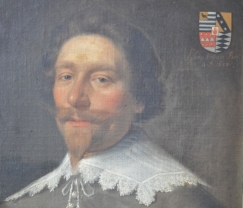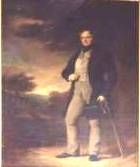
Sir John Hotham, 1st Baronet of Scorborough Hall, near Driffield, Yorkshire, was an English Member of Parliament who was Governor of Hull in 1642 shortly before the start of the Civil War. He refused to allow King Charles I or any member of his entourage to enter the town, thereby depriving the king of access to the large arsenal contained within. Later in the Civil War he and his son John Hotham the younger were accused of treachery to the Parliamentarian cause, found guilty and executed on Tower Hill.
Richard de Lucy, Luci, Lucie, or Lusti, also known as Richard the Loyal, was first noted as High Sheriff of Essex, after which he was made Chief Justiciar of England.

Boconnoc is a civil parish in Cornwall, England, United Kingdom, approximately four miles (6 km) east of the town of Lostwithiel. According to the 2011 census the parish had a population of 96.

Prideaux Place is a grade I listed Elizabethan country house in the parish of Padstow, Cornwall, England. It has been the home of the Prideaux family for over 400 years. The house was built in 1592 by Sir Nicholas Prideaux (1550–1627), a distinguished lawyer, and was enlarged and modified by successive generations, most notably by his great-great-grandson Edmund Prideaux (1693–1745) and by the latter's grandson Rev. Charles Prideaux-Brune (1760–1833). The present building, containing 81 rooms, combines the traditional E-shape of Elizabethan architecture with the 18th-century exuberance of Horace Walpole’s Strawberry Hill Gothic.

Trerice is an historic manor in the parish of Newlyn East, near Newquay, Cornwall, United Kingdom. The surviving Tudor manor house known as Trerice House is located at Kestle Mill, three miles east of Newquay. The house with its surrounding garden has been owned by the National Trust since 1953 and is open to the public. The house is a Grade I listed building. The two stone lions on the front lawn are separately listed, Grade II. The garden features an orchard with old varieties of fruit trees.
Charles Anderson-Pelham, 1st Baron Yarborough FRS FSA was a British politician.

Finborough School is a co-educational independent school. It is situated in and around Finborough Hall, in the village of Great Finborough, near Stowmarket, Suffolk, England.

JoscelinePercy, 11th Earl of Northumberland, 5th Baron Percy, of Alnwick Castle, Northumberland and Petworth House, Sussex, was an English peer.

Colonel William Wollaston was a British Member of Parliament for Ipswich between 1768 and 1784.
Sir Thomas Stanhope was the son and heir of Sir Michael Stanhope, and a Member of Parliament for Nottinghamshire.

Finborough Hall is a Grade II listed stucco-faced Tuscan-style country house in Great Finborough, Suffolk, England.

Tapeley is a historic estate in the parish of Westleigh in North Devon, England.

Lewis William Buck (1784–1858) of Moreton House, Bideford, and Hartland Abbey, Devon, was Member of Parliament for Exeter 1826–32 and for North Devon 1839–57, and was Sheriff of Devon in 1825/6. A full-length portrait of Lewis William Buck by Francis Grant (1803–1878) was presented to him by the people of North Devon after he had served eighteen years as their MP, now displayed in the billiards room of Hartland Abbey, with his electioneering posters on each side.

Oxton in the parish of Kenton in South Devon is a historic estate long held by the Martyn family, a junior branch of the Norman family of FitzMartin, feudal barons of Barnstaple.

The Pettiward Estate is a privately owned set of reversions in the far edge of two inner boroughs of south-west London, England, now owned by a family trust of the family, who were from 1794 until 1935 of Finborough Hall, Suffolk. The family oversaw and took a direct involvement in much of the speculative development of these areas: parts of West Brompton and small parts of Putney.

Gittisham is an historic manor largely co-terminous with the parish of Gittisham in Devon, England, within which is situated the village of Gittisham. The capital estate is Combe, on which is situated Combe House, the manor house of Gittisham, a grade I listed Elizabethan building situated 2 1/4 miles south-west of the historic centre of Honiton and 3 1/4 miles north-east of the historic centre of Ottery St Mary.
The manor of Hillersdon was a historic manor in the parish of Cullompton, Devon, England which was held by the de Hillersdon family from the 13th century until the early 16th century. It was then held by a number of different families including the Cockeram, Cruwys and Grant families. Hillersdon House was built in the nineteenth century by the Grant family and is still in use.

Hayne in the parish of Stowford in Devon, is an historic manor, about 11 miles (18 km) south-west of Okehampton. The surviving manor house, a Grade II* listed building known as Hayne House, was rebuilt in about 1810 by Isaac Donnithorne, who later adopted the surname Harris having married the heiress of Harris of Hayne.
Joseph Alcock (1760–1821) was a British Civil Servant in the Treasury between 1785 and 1821.

Roger Pettiward (1754–1833) was an English businessman and antiquarian. He was elected a Fellow of the Society of Antiquaries in 1788, and a Fellow of the Royal Society in 1815.















